
The de Havilland Aircraft Company Limited was a British aviation manufacturer established in late 1920 by Geoffrey de Havilland at Stag Lane Aerodrome Edgware on the outskirts of north London. Operations were later moved to Hatfield in Hertfordshire.

The de Havilland DH.110 Sea Vixen is a British twin-engine, twin boom-tailed, two-seat, carrier-based fleet air-defence fighter flown by the Royal Navy's Fleet Air Arm from the 1950s to the early 1970s. The Sea Vixen was designed by the de Havilland Aircraft Company during the late 1940s at its Hatfield aircraft factory in Hertfordshire, developed from the company's earlier first generation jet fighters. It was later called the Hawker Siddeley Sea Vixen after de Havilland was absorbed by the Hawker Siddeley Corporation in 1960.
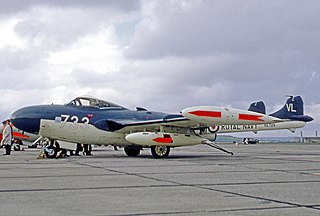
The de Havilland DH.112 Sea Venom is a British postwar carrier-capable jet aircraft developed from the de Havilland Venom. It served with the Royal Navy Fleet Air Arm and with the Royal Australian Navy. The French Navy operated the Aquilon, developed from the Sea Venom FAW.20, built under licence by SNCASE (Sud-Est).
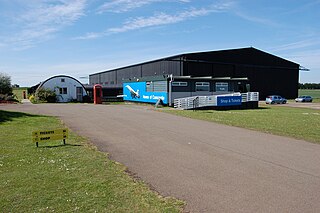
The National Museum of Flight is Scotland's national aviation museum, at East Fortune Airfield, just south of the village of East Fortune, Scotland. It is one of the museums within National Museums Scotland. The museum is housed in the original wartime buildings of RAF East Fortune which is a well preserved World War II airfield. As a result of this the entire site is a scheduled monument with no permanent structures added by the museum. The hangars, control tower and stores were designated as Category B listed buildings by Historic Scotland, but this designation was removed in 2013 as they were already covered by the stricter scheduling.

The Rolls-Royce Avon was the first axial flow jet engine designed and produced by Rolls-Royce. Introduced in 1950, the engine went on to become one of their most successful post-World War II engine designs. It was used in a wide variety of aircraft, both military and civilian, as well as versions for stationary and maritime power.

The de Havilland Aircraft Museum, formerly the de Havilland Aircraft Heritage Centre, is a volunteer-run aviation museum in London Colney, Hertfordshire, UK.

The Fleet Air Arm Museum is devoted to the history of British naval aviation. It has an extensive collection of military and civilian aircraft, aero engines, models of aircraft and Royal Navy ships, and paintings and drawings related to naval aviation. It is located on RNAS Yeovilton airfield, and the museum has viewing areas where visitors can watch military aircraft take off and land. At the entrance to the museum are anchors from HMS Ark Royal and HMS Eagle, fleet carriers which served the Royal Navy until the 1970s. It is located 7 miles (11 km) north of Yeovil, and 40 miles (64 km) south of Bristol.

The de Havilland DH.60 Moth is a 1920s British two-seat touring and training aircraft that was developed into a series of aircraft by the de Havilland Aircraft Company.

The DH.83 Fox Moth is a small biplane passenger aircraft from the 1930s powered by a single de Havilland Gipsy Major I inline inverted engine, manufactured by the de Havilland Aircraft Company.

The de Havilland DH.94 Moth Minor was a 1930s British two-seat tourer/trainer aircraft built by de Havilland at Hatfield Aerodrome, England. With the start of the second world war production of the Moth Minor was moved to de Havilland Australia at Bankstown Aerodrome, Australia.
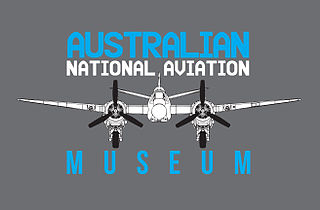
The Moorabbin Air Museum is an aviation museum at Moorabbin Airport in Melbourne, Victoria, Australia. It was founded in 1962 as the Australian Aircraft Restoration Group, in an attempt to maintain a World War II-era Bristol Beaufighter aircraft. It has since become a museum, with a large aircraft collection. It was known as the Australian National Aviation Museum up until October 2021. As of 2021 it held nearly 60 aircraft and 25 engines.

RAAF Museum is the official museum of the Royal Australian Air Force located at RAAF Williams Point Cook, Victoria, Australia. The museum displays aircraft of significance to the RAAF from its inception as the Australian Flying Corps to the present.
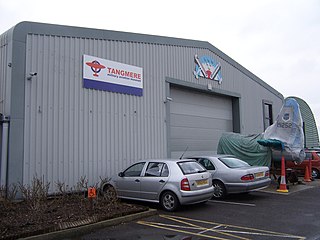
The Tangmere Military Aviation Museum is a museum located on the former site of RAF Tangmere, West Sussex. The museum was opened in June 1982. Many aerospace exhibits covering the First World War to the Cold War are on display including fixed-wing aircraft, helicopters and aircraft engines.

The Gatwick Aviation Museum is located in the village of Charlwood, in Surrey, United Kingdom on the boundary of Gatwick Airport.
Hants and Sussex Aviation Ltd was a British aviation manufacturer. Based at Portsmouth Airport, Hampshire, England, throughout much of its existence, the company is still in business in the aircraft components industry.

Solent Sky is an aviation museum in Southampton, England.

The Aviation Heritage Museum is a museum located in the Perth suburb of Bull Creek in Western Australia. Created and maintained by the Air Force Association of Western Australia, it houses many military and civilian aircraft, aircraft replicas and aircraft engines, of types that have served in the Royal Australian Air Force or that have relevance to aviation in Western Australia.

The Historical Aircraft Restoration Society, often referred to by its acronym, HARS, is an Australian based aircraft restoration group. The group has two museums, at Shellharbour Airport in New South Wales, Australia, and Parkes, New South Wales, Australia. HARS was formed in 1979 by a group of aviation enthusiasts interested in the preservation of Australian Aviation History. Its mission is "To recover and where possible restore to flying condition, aircraft or types of aircraft that have played a significant part in Australian Aviation History both in the Civil and Military arenas".
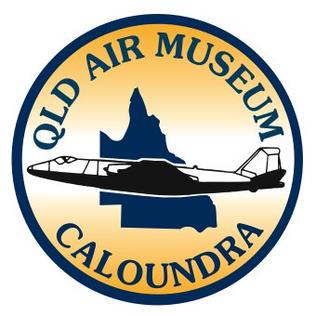
The Queensland Air Museum is a not-for-profit all-volunteer aviation museum located near the Caloundra Airport in Queensland, Australia. Its mission is to collect and preserve all aspects of aviation heritage with an emphasis on Australia and Queensland. The museum has the largest and most diverse collection of historic aircraft in Australia and it also has a large collection of aircraft engines, equipment, artefacts, photographs, uniforms and books.
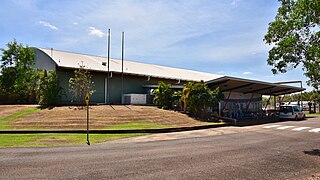
The Darwin Aviation Museum, previously known as the Australian Aviation Heritage Centre, displays aircraft and aircraft engines of relevance to the Northern Territory and aviation in Australia generally. It is located in Darwin suburb of Winnellie.

























